Text
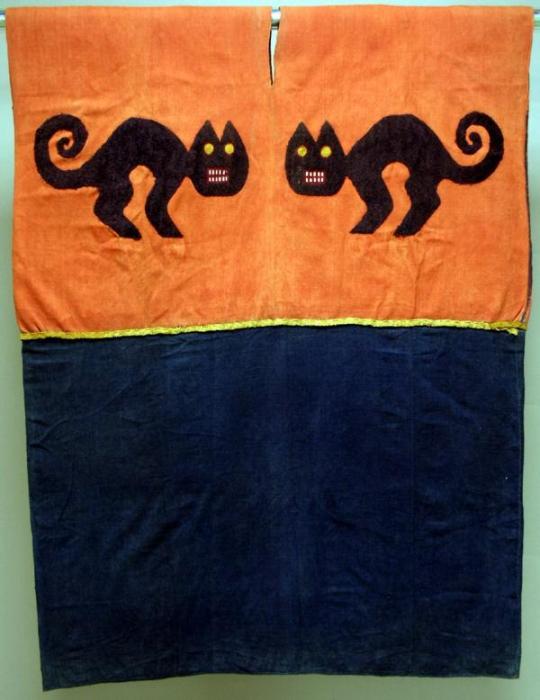

Peruvian sleeveless tunic.
15th–early 17th century. Cotton and camelid hair. The Metropolitan Museum of Art.
Artstor.
2K notes
·
View notes
Text

How to instantly make any outfit better.
528 notes
·
View notes
Text
Your warp is gorgeous. May any mistakes that come along be glorious to match it!
Someone yell at me to do maths, my loom is crying out to be used but I need to do calculations first
72 notes
·
View notes
Text
All of this, pretty much. I wash my swatches rather than rest them because I know I'll eventually have to wash the finished object anyway. Same end result though.
And like, there's ways to make *actual projects* that just also happen to be a swatch for the "real" project. I'm partial to TECHknit's gaugeless ski hat with TKIO as a swatch for things knit in the round.
When I make posts about gauge swatching half the replies are "I refuse to knit gauge swatches and yeah my stuff never turns out right but I just suffer lmao"
What are you, Catholic? Knit a swatch!!
#knitting#swatches don't lie. they tell you what your gauge is for that size piece of knitting with those needles and yarn#so yes sometimes you don't get the same result in the finished piece#most of the time it's still faster and easier to swatch for complex work though
336 notes
·
View notes
Text
Oh boy. I think you know not what you ask. I've been pickling my brain in textiles for years.
I will preface this by saying I don't think these are necessarily the best, or even the most accurate, resources out there - this is just what I've managed to get my hands on. As always, do your best to check sources, and side-eye anything that doesn't tell you where it got its information.
When I say "the historical devaluation of textile labour", I mean it in two different ways. The first is "for pretty much the entirety of human history up until the Industrial Revolution, materials were expensive and labour was cheap". That doesn't mean people couldn't make a living wage as a textile worker - in many places, times and jobs, you could live reasonably well. In quite a lot more, though, textile work was a subsistence practice that added to the household economy. When it wasn't being done by slaves, that is - a depressingly common practice from the Bronze Age all the way through to today.
The second is "fast fashion brands worked hard to rewrite the textile landscape and have completely broken the modern consumer's idea of what clothing 'should' cost". They did this by leveraging economies of scale to make the materials cheap, plus continuing the fine Victorian tradition of using near-slave labour in the factories.
Time and Money
Honestly, I encourage everyone to time their own work over at least one project. Money is not the only currency in the world, and I think it's important to recognise our contributions to our own happiness. There's just something about being able to say "It took me 12 hours to knit this pair of socks" (my current average on 2mm needles, with no patterning) that, for me, helps drive home the true worth of non-monetary activities.
I know that that's not easy or accessible for many, though, so here are some other tidbits.
Matsukaze Workshops is an SCA member recreating historical garments, who tells you the time and materials cost on just about every project. (Note that we modern humans are almost certainly slower than period humans would have been because we 1) have different attitudes about our clothes and the level of workmanship we expect, 2) don't spend anywhere near as much time doing it as our ancestors did, and 3) don't have the pressure of "if I don't finish this in time we will freeze to death" to motivate us.)
From Cornish Guernseys and Knit-Frocks by Mary Wright, we learn that contract knitters in the 1800s were fast - much faster than the average knitter today - and if you were good at it, you could earn more through knitting than by going out to service:
At the beginning of this century {the early 1900s}, women were paid 3s. 6d (17.5 pence) for a 'fancy' knit-frock; 2s. 6d (12.5 pence) or 2s. 9d. (14 pence) for a plain one. An eighty-year-old lady pointed out that only 2s. (10 pence) was paid if a fault were found in the knitting. The yarn was received in 2lb (900g) hanks (cost 4s. [20 pence]) and was wound by the knitters. An experienced contract knitter could complete a guernsey in about a week. Comparative wages in the late nineteenth century were 'Bal maidens at £10-£11 per year; a 'thoroughly competent and experienced woman servant at £8 per year', and 'domestic servants at 9d. (about 4 pence) a week'. (--pp21-22)
Unfortunately for a lot of poor families, that didn't last. Hazel Tindall, one of the fastest knitters in the world, talks about contract knitting in the Shetlands in the 1960s in this YouTube podcast. She doesn't give figures, but she does mention that she knit the yokes onto machine-knit bodies, usually finishing an adult jumper in about three hours. It didn't pay much, but many knitters were from poor households who didn't have much choice but to knit for what little they were given.
We also have a section from The Costume of Yorkshire (1814), excerpted from this V&A article:
A woman by the name of Slinger who lived in Cotterdale was accustomed regularly to walk to market at Hawes, a distance of three miles, with the weekly knitting of herself and her family packed in a bag upon her head, knitting all the way. She continued her knitting while she stayed in Hawes, purchasing the little necessities for her family, and worsted for the work of the ensuing week. She was so expeditious and expert that the produce of the day's labour was generally a complete pair of men's stockings.
I've seen a few places reference the charity schools of the Victorian era as well, stating that a child needed to be able to knit a stocking in a week before they were allowed to attend. I haven't been able to confirm or deny that via reputable sources, though. (I should probably ask on r/AskHistorians, one of the few genuinely good subreddits for history. It's heavily moderated by actual historians and all answers must be in-depth and properly cited.)
Reading/Viewing Recs
🎥 Fast Fashion is Hot Garbage: A decent 15 minute, high-level overview of all the ways fast fashion is terrible, ending with how we fix it (spoiler: it's policy change. It always comes back to pressuring politicians.) There's a good list of references in the video description too.
Overdressed by Elizabeth Cline: One of the first popular books that drew attention to the rising problems with the fast fashion industry. While it was written in 2011, it's still depressingly relevant today. Elizabeth has also written a book on ways to more mindfully/ethically engage with fashion, called The Conscious Closet.
A Short History of the World According to Sheep by Sally Coulthard: This is a pop-history grand tour, but its chapters on the English wool industry from medieval times through Industrialisation are a good summation of how textile workers were both the backbone of the economy and also just ... not treated particularly well in the aftermath of the Black Death in the 1300s. This quote about the woollen mills in Bradford post-Industrialisation is particularly telling:
In 1843, one health commissioner declared Bradford to be the ‘dirtiest, filthiest, worst regulated town in the kingdom’ while Georg Weerth, a radical German pamphleteer and good friend of Karl Marx, famously wrote in 1846, ‘Every other factory town in England is a paradise in comparison to this hole […] in Bradford, however, you think you have been lodged with the devil incarnate. If anyone wants to feel how a poor sinner is tormented in purgatory, let him travel to Bradford.’
Things were bad, even by the standards of the day – average life expectancy among textile workers was just eighteen years of age.
Keep in mind that when Marx was railing against the evils of capitalists, he was talking about places like Bradford. The factory owners routinely locked people inside for 16+ hour shifts, paid people to kidnap children to work the factories, and waged fierce propaganda campaigns along the lines of "we're giving the poor city kiddies fresh country air and gentle exercise while they earn a living, we're the good guys actually".
Women's Work: The First 20,000 Years by Elizabeth Wayland Barber: link is to the 30th anniversary edition coming out this year; I have the original, which you can also borrow/read online from the Internet Archive with a free account. This book covers a lot of ground, as you can imagine from the title. I think the biggest takeaway for me, though, is the fact that neolithic societies generally put way, way more effort into making their textiles fancy than they "should" have, by modern notions. Take Stone Age Europe, 5,000 years ago:
All over central Europe women were inventing more and more elaborate textiles, regardless of modern economists’ models. One of the key issues to understanding this “extravagance” is time. Not only were there infinitely fewer entertainments tugging at one’s attention in a preindustrial rural setting, but expenditure of time was viewed very differently from the way it is within an industrial economy. To us, time is money ... For them, money was irrelevant because it hadn’t been invented yet, nor would it be for another twenty-five hundred years. So there was nothing to weigh time against; it simply was what it was... Time was thus constantly available for use to promote survival, whether directly (e.g., by preparing food and building shelter) or indirectly—that is, by trying to elicit symbolically what was wanted.
This is something that many of us can relate to, when we're making things. Why else would sock knitters use fancy indie dyed yarns, or complex colourwork, or allover cables or lace patterns? We do it for us, because we know the value of the thing we've made for ourselves.
Our ancestors were no different. The Minoan women, for instance, had fantastically complex patterning on their attire -
What were the pretty patterns the Minoans liked so much to weave? The first favorite on exports to Egypt, to judge from copies painted there from around 2000 B.C. onward, consisted of blue heart-spirals set point to point (much like the design typical today on a wrought-iron fence) with a red diamond between each pair of double hearts, all on a white ground (fig. 4.4). It must have been stunning. At any rate, the women of Crete wove that design for at least another thousand years, for we catch glimpses of it here and there both in Egypt and in Crete, all the way down into the Iron Age long after the fall of the Minoans.
And just like today, you got both worse and more boring results when bosses told you what you had to make:
Working within a quota system of production is not like weaving for oneself. It is no longer fun, nor does the weaver get the benefit of extra effort put in. Mass production is not at all like making single pieces at will; there isn’t time to do a careful job. This economic principle is illustrated many times in history... The same effect is visible in Cretan textiles made for the central palaces, under Mycenaean rule, as they rapidly became plain with at most a fancy edging. Elsewhere on Crete, however, in remote areas that the Mycenaeans failed to subjugate, the Minoan women continued to make their elaborate fabrics all the way down into the Iron Age.
As I said above, r/AskHistorians is a surprisingly good resource for specific queries. The subreddit has a massive archive to search through. This ask about that "spinsters in the middle ages were empowered girlbosses actually" meme that was going around a while back is relevant here.
A Bunch of Stuff I Haven't Tracked Down Yet But I'm Told is Very Good
The Valkyries' Loom: the Archaeology of Cloth Production and Female Power in the North Atlantic. "While previous researchers have overlooked textiles as insignificant artifacts, Hayeur Smith is the first to use them to understand gender and economy in Norse societies of the North Atlantic. "
This Golden Thread: How Fabric Changed History. "Exploring the enduring association of textiles with 'women’s work,' Kassia St. Clair 'spins a rich social history . . . that also reflects the darker side of technology'".
Blood in the Machine: Juxtaposes the history of the Luddites and their fight against factory owners with the fight we're all currently in against Big Tech and AI. Cory Doctorow reviews it here. As he says: "To be a Luddite is to demand a say in the future. It's not enough to ask what a machine does - we have to ask who it does it for and who it does it to."
There is almost certainly more that I've forgotten or have lost links for, but hopefully these help!
Can someone please explain to me WHY no one can accept that I knit for pleasure?? Every time someone compliments me on my knitting they ask me if I've thought about selling it. NO GOD DAMMIIT NOT EVERYTHING HAS TO BE A SIDE HUSTLE
It would take all the pleasure out of it.
Bring back people doing things for fun. Jesus.
#honestly reading widely and critically gets you quite far. I'm constantly amazed at the offhand comments that send me down rabbitholes#textiles#history#resources
3K notes
·
View notes
Text
I'm currently climbing Walls of Awful on three (3) separate projects and yes. This. All of this.
It's like Yes! Finally! I have worked out how to do the thing! The hardest part is over! All I have to do now is put in hours upon hours of tedious, meticulous, constant hard graft and I shall have the thing! Easy as!
Apparently people who don't have executive dysfunction think that actually working on something is the hardest part of doing something. And that's why they get mad that you call the rest of the project "easy" after you've finally worked through doing the plan and know what to do when you're working.
So when you're through with the epiphany of how to make it physically possible to make the thing you're making, and you're sharing the plan with excitement, because the hard part is over, and now you only have to get your hands moving and do it, they get mad at you like
"it's not that easy! It's a lot of hard work! >:C"
they mean it, because
to them, working is the hardest part.
They don't have to fight their brains to get started. They don't have to fight their way through making the choices, making the plan, making yourself make the thing. People who don't suffer from executive dysfunction think that the hardest part is actually doing the thing.
#I lost the pattern instructions for one jumper. now I must spend the next X time turning over every single aspect of How To Make in my head#and then if I'm lucky I'll be able to actually get on with the making#the shirt in time out knows what it did#and we shall not speak of the raddle-less loom warping debacle which I need to work out how to fix before May Day
45K notes
·
View notes
Text
I've not used this brand before, but I do almost exactly the same thing with other compacted fibres (the most egregious offenders are often from indie dyers), and it works great.
Another good method, especially for fine fibres, is steaming. It fluffs a lot of commercially carded/combed fibres right up and makes them much easier to tease apart if it still needs more work before you start spinning.
The easiest way is to hang the braid (take it out of its plait first) in the bathroom while you shower. My bathroom isn't that steamy, though, so I hold the fibre over a kettle. You can also use a pot of simmering water on the stove. Do keep yourself safe while doing this - scalds are no fun.
For @squeakpip
A quick guide on how I prep Malabrigo Nube for spinning because I agree it is a frickin‘ nuisance. That said, the colours are SO gorgeous Malabrigo Nube deserves a better rep haha!

Braid fresh from the store. A compacted, clumpy mess that made lil beginner Bronzie cry multiple times. But fear not!
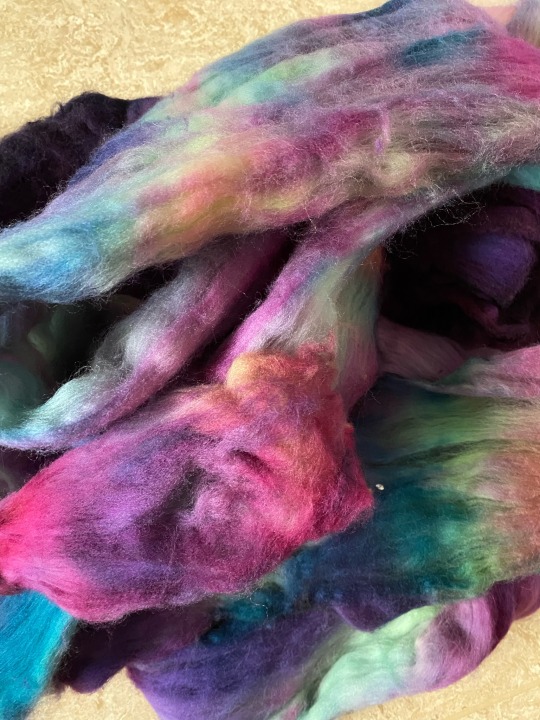
Unravel the whole braid and starting at one end, gently pull the fibers apart width-wise. Don‘t rip the braid, just fluff it up, really get into those clumps with your fingers. Like a bird preening its feathers. Remove overly matted „dreadlocks“ and other felted pieces, nobody needs those.
Now pull through a diz (a salad strainer or DIY version will do) TWICE. First through a bigger hole, then through a finer one. Take your time. Yes it will take what feels like forever, but it‘s well worth it I promise!!

These are the two holes I use on my succaplokki diz. First the bigger hole, then the smaller. You might have to go over some matted spots again while you pull the wool through the diz. Again, listen to some music, or a podcast, take your time. Do not prep Nube when you‘re stressed or in a hurry.
A warning: Your hands WILL hurt. Please stretch and take breaks. Also it‘s possible the braid will break when it suddenly gives after being stubborn, but just accept that and continue.

Once it‘s done, you are finally met by a beautiful, soft, plushy, fluffy rainbow worth being spun!!! And it will be fun and relaxing and a total difference to the matted compacted mess you bought. Go forth and love Nube :D
151 notes
·
View notes
Text
The practice is called steganography and people have been using it (and still are!) in different ways for centuries. You can read about some historical and modern examples here: https://textileartscenter.com/feature/hiding-in-the-light/
Historian: People used to knit Morse code to tell people secret messages during the war.
Me: So you're telling me I can make my sister a hat that says "butt face" and she won't know unless she learns Morse code? Tell me more-
144 notes
·
View notes
Text
You have every right to be proud, this is absolutely gorgeous!
So, I crochet.
And I know this is where I put my fic and stuff. But except for occasional life updates I tend to keep it to that.
But.
I've worked on this for 3 months and I'm proud as absolute hell.
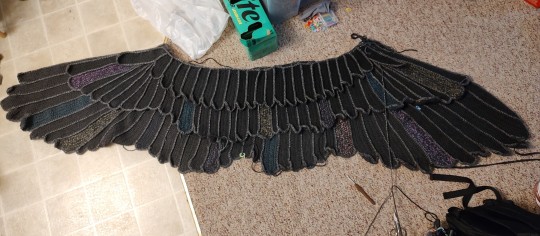
It measures around 6 1/2 ft (214cm) across and I'm quite proud.
I still have to actually assemble it, and that is going to be a whole ordeal, but still.
I'm really proud of this.
Not being able to work and struggling to write with all my recent health issues has really taken a lot out of me. Just kind of sitting around being useless and expensive.
But I MADE this.
With my own two hands.
And it feels good to actually make something.
So yeah.
Just thought I'd share.
Love y'all.
- Lacy
828 notes
·
View notes
Text
Another, less fun fact - there's specific cuts of suit you can ask for when shopping to allow for this.
They're aimed at security professionals, like the Secret Service or bodyguards who do high profile work, but that doesn't mean you can't also have the freedom of movement to dance on tables and chairs!


#fashion#it's not rocket science but it DOES require a good knowledge of tailoring cut and construction
992 notes
·
View notes
Text
Gorgeous!
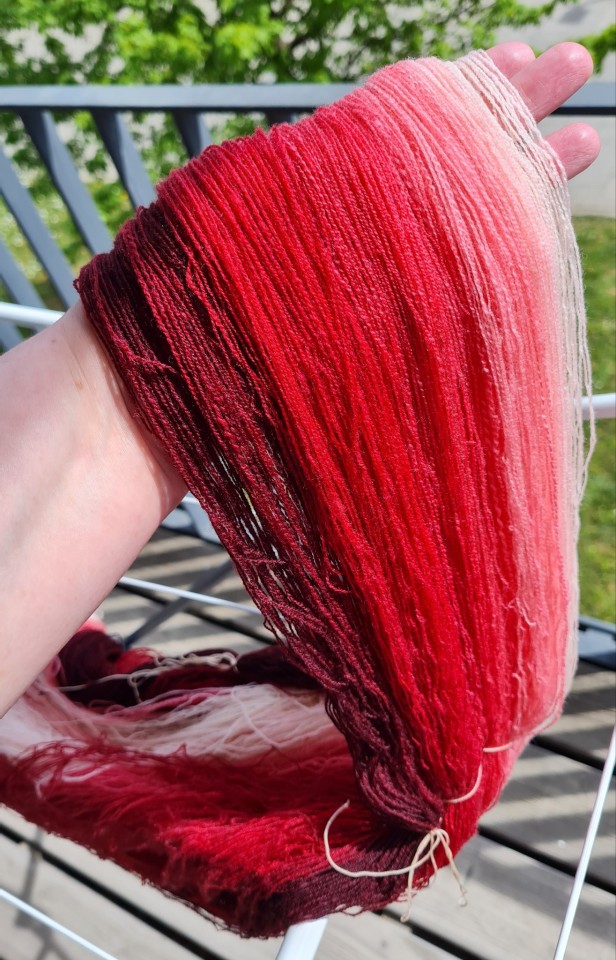
freshly washed and dripping all over my balcony
73 notes
·
View notes
Text
I suddenly see exactly where the "we build everything out of pallets" people are coming from, that's for sure. Even buying paint or sealant or whatever would cost less than that obscenity.

These things are made of garbage and glue and they want to charge this much for them??? Seriously considering just buying some real wood and making it myself. We tolerate this chipboard crap BECAUSE IT'S SUPPOSED TO BE INCREDIBLY AFFORDABLE.
2K notes
·
View notes
Text
They haven't even finished all the board ends?? IT DOESN'T COME WITH DRAWER RUNNERS?!
I knew things had gone to shit but what even is this.

These things are made of garbage and glue and they want to charge this much for them??? Seriously considering just buying some real wood and making it myself. We tolerate this chipboard crap BECAUSE IT'S SUPPOSED TO BE INCREDIBLY AFFORDABLE.
2K notes
·
View notes
Text
Excuse me, I need to sit back and thousand yard stare at the sheer skill it took to make this.
I came across this in a book I'm currently reading and it's really stuck in my mind and I wanted to share

'Sheep in Wolf's clothing' by Judith Duffey 1986
I don't know if anyone on here is going to be interested I'm this piece or anything but I wanted to share as it struck me an an amazing piece of textile art
2K notes
·
View notes
Text
Reggie is ADORABLE.
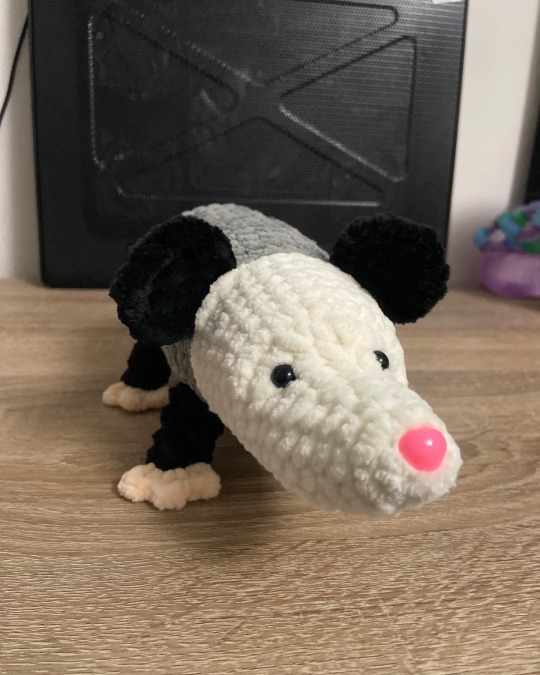
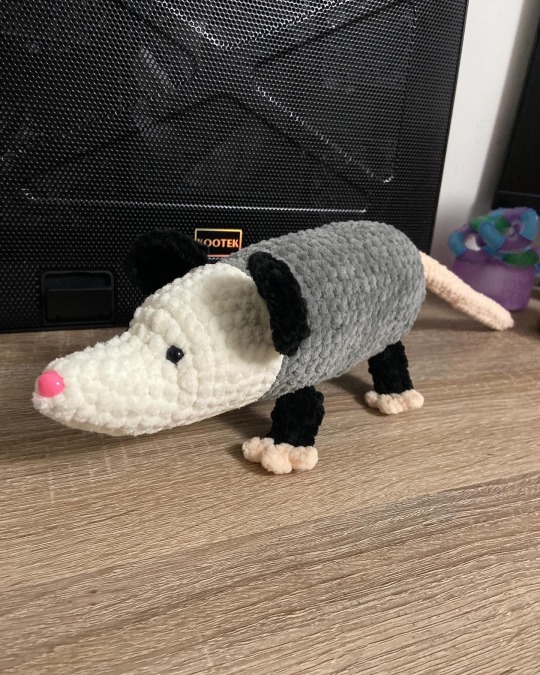
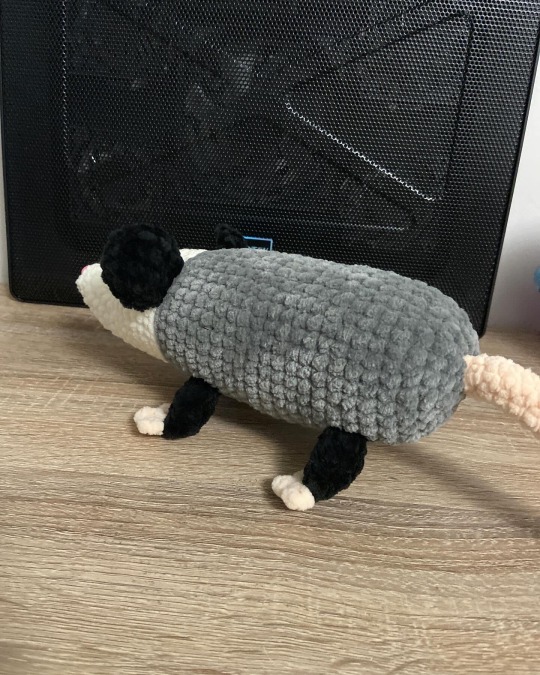

Crocheted an opossum! His name is Reggie! He’s just chillin.
Took 6 hours of work!
I customized the pattern a little bit. Og pattern has the opossum lay flat on the ground, but I wanted him to stand, so I just add an extra stitch when sewing to let him stand.
Pattern was from Etsy, I made the kit but they have different options.
7 notes
·
View notes
Text
That is one chill rabbit.
I'll answer some frequently asked questions about this.
Angoras have been bred for hundreds of years for their temperament. These rabbits require so much grooming, they need to be able to tolerate and even enjoy it. Spinning directly off of them isn't much different than brushing, or gently plucking.
I don't do this for long stretches, about two to five minutes at a time. This isn't a very efficient method, I spin right off of them to demonstrate it doesn't bother them to give up their fiber. It's all about education.
I gently pluck the fiber before the twist goes into it, so their skin is never twisted or yanked on. The wool is released from the skin very easily when they are molting.
I've spun off of about eight angora rabbits, they all tend to just chill out. This one in the video is Petunia.
5K notes
·
View notes
